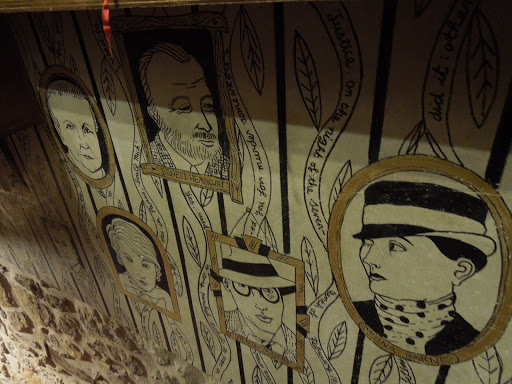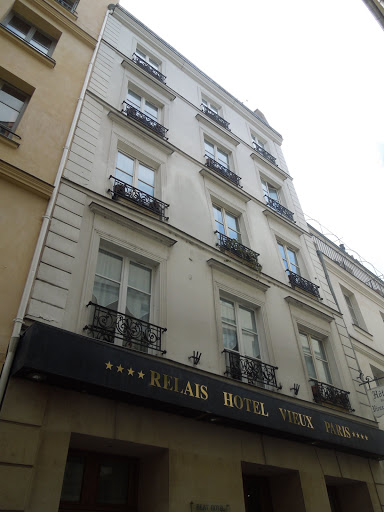"You are all a lost generation," insisted Gertrude Stein. The importance of this statement is disputable, since what generation is otherwise? But it made for good copy and paved the way for generations Beat, X, and Pepsi. In the wake of the Great War, the members of une génération perdue made their way to Paris, where artists could live cheaply, and drunkenly, unlike in the States where Prohibition reigned.
I took a few hours one drizzly afternoon to wander through the Latin Quarter and Saint-Germain-des-Prés districts seeking out a few old literary haunts.

Shakespeare and Company, at 37 rue de la Bûcherie near the Seine. Opened in 1951 under the name Le Mistral, this bookstore was later renamed as a tribute to Sylvia Beach's influential bookstore which catered to the Lost Generation in the twenties. Aside from having an intimidating selection of English language books, Shakes & Co has a reputation for being notoriously supportive of struggling writers, even so far as letting them crash on an upstairs cot in exchange for a few hours of work. Its beloved owner George Whitman passed away in 2011, leaving the shop in the hands of his daughter Sylvia.

A mural of writers along the stairway. Clockwise: Gertrude Stein, Ernest Hemingway, Djuna Barnes, Henry Miller, Jean Rhys.

The upstairs room at Shakespeare and Company is filled with the dusty remnants of Sylvia Beach's library.

Les Deux Magots was a favorite meeting place of intellectuals and writers such as Jean-Paul Sartre, Simone de Beauvoir, Camus, André Gide, Jean Cocteau, and André Breton.

The two magots, silk traders from the provinces who opened a fabric shop on this location in 1873.

Café de Flore on Boulevard Saint-Germain was another favorite hangout of the existentialists and painters like Picasso and Marc Chagall.


Hemingway wrote about La Closerie des Lilas in A Moveable Feast, one of his favorite spots to write, at least until the restaurant converted to an American Bar and a waiter was indignantly forced to shave off his mustache.

27 rue de Fleurus was the home of Gertrude Stein and Alice B Toklas, an art-bedecked salon for expatriates. Ezra Pound, Hemingway, Picasso, Thornton Wilder, and Sherwood Anderson were a few of the notables prone to dropping by to endure Stein's sharp criticisms.
 '
'
Hemingway moved to this stately apartment at 6 rue Férou after The Sun Also Rises was published and the money started rolling in.

Henry Miller lived in a fifth floor garret of this hotel at 36 rue Bonaparte for 500 francs a month. He wrote detailed letters about his time here to his childhood friend Emil Schnellock, later collected in the volume titled, appropriately, Letters to Emil.

In 1921 Sylvia Beach moved her fledgling bookstore Shakespeare and Company to this address at 12 rue de L'Odeon, where expatriates soon gathered to schmooze and take advantage of Beach's lending library. Beach was the only soul brave enough to publish James Joyce's Ulysses in 1922. The shop was eventually shut down by Nazis during the occupation.

While waiting under an awning for the rain to let up I noticed with envy this shop window full of vintage Jules Verne.

This former flophouse at 9 Rue Gît-le-Coeur was known as the Beat Hotel, where various Beat Generation writers stayed when they were in town in the fifties because the prices were so cheap. Today they probably wouldn't be able to enter the lobby of this now-upscale joint without raising suspicion.


James Joyce lived here at 71 rue du Cardinal Lemoine while putting the finishing touches on Ulysses.


Down the street from Joyce, Hemingway lived on the third floor of 74 rue du Cardinal Lemoine when he first arrived in Paris. The boutique on the ground floor is called Under Hemingway's.

The symbolist poet Paul Verlaine died of pulmonary congestion here at 39 rue Descartes. Hemingway also rented a garret in the building for use as a writing room.

George Orwell stayed in this former boarding house at 6 rue du Pot de Fer while working as a dishwasher in the ground floor restaurant. A narrative on his foray into poverty was published in 1933 as Down and Out in Paris and London.

A glance upwards.

Across the Seine on the Right Bank, at the southeast corner of Place des Vosges, lies the stately Maison de Victor Hugo. The legendary French novelist and poet lived here for sixteen years, where he penned a large portion of Les Misérables. It is now preserved as a museum.

Marcel Proust's bedroom where he painstakingly pieced together the seven volumes of À la recherche du temps perdu is on display at the Musée Carnavalet. The walls were lined with cork to muffle the noise of the city.
11 May 2012
Literary Paris
Subscribe to:
Post Comments (Atom)
No comments:
Post a Comment